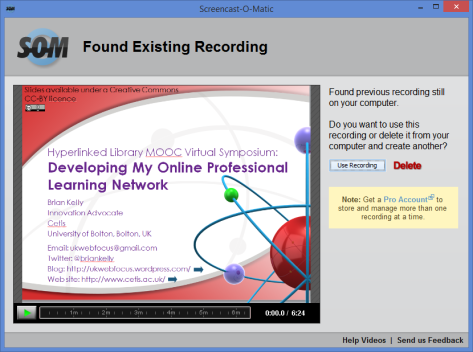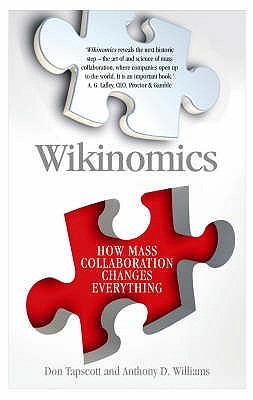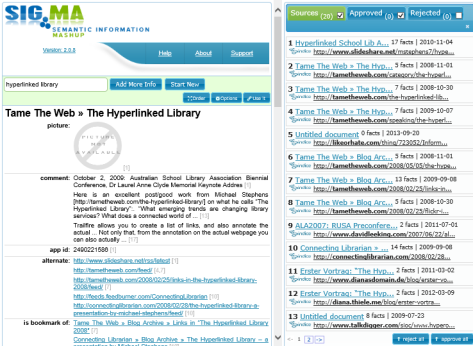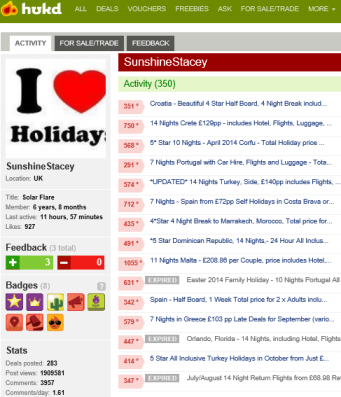About the Final Assignment in the Hyperlinked Library MOOC
The final assignment for the Hyperlinked Library MOOC requires participants to produce a Director’s Brief. The Director’s Brief provides participants with:
the opportunity to hone in on a technology-enhanced service that was mentioned through the course content or lectures, or perhaps you encountered it in conversations with your peers. Situated as a report-of-sorts for a library director, you’ll be crafting a brief that informs your administrator of its origins, related terminologies, uses for LIS environments, and addresses its potential pitfalls.
The requirements for this assignment are to:
write an examination of an emerging technology of your choice. Craft the report as though you are sending it to your library director, a technology planning group, or the recipient of your choice (to fit your career goals). The brief should be structured in logical fashion following these points:
- What is the technology? Define any terms or related vocabulary.
- What should the recipient understand about the technology? Affordances? Negative issues?
- How do user populations use it?
- What research or studies can inform the decision to plan and implement?
- How can libraries successfully implement it?
The report should be 800 to 1000 words and can include graphic elements and screenshots to enhance this type of report depending on the technology chosen.
The Context for this Director’s Brief
Scenario
The scenario for this director’s brief is as follows:
The Library at the (fictitious) University of Poppleton has decided to embrace Open Educational Practices in order to (a) enhance the quality of the learning experiences and employment prospects for its students; (b) enhance the visibility of its research activities and (c) support its engagement with the local community.
In order to implement these aims the Library, IT Services department, Student Enhancement Unit, Research Support Unit and the Centre for Widening Participation have been asked to describe plans which will ensure that these key strategic goals are being addressed. The university’s senior management teams has made it clear that only very limited additional funding is available; preference will be given to proposals which require little or no additional funding. In order to minimise risks that inappropriate proposals are accepted, proposals should clearly document associated risks.
The Library has decided to focus on use of Wikipedia since the community encyclopedia and related services are felt to be able to support these goals with relatively little investment of effort.
The university has asked Cetis, the Centre for Educational technologies and Interoperability Standards, a national centre for the UK’s higher and further education communities to provide a report on ways in which the library can make use of Wikipedia services as a key aspect of its Open Educational Practices.
I should add that although the University of Poppleton does not exist, Cetis does! Since 28 October 2013 I have been employed at Cetis as an Innovation Advocate.
In the planning for the Director’s Brief I have used the planning process for the HyperLinked Libraries Emerging Technology Planning assignment which suggested that students should use the following structure to assist planning of technological developments:
Convince ______ that by _______ they will ________ which will ________ because _______.
In my case I will aim to:
Convince the senior management team in the Library that by promoting creation and maintenance of content using Wikipedia and Wikimedia Commons they will provide a cost-effective way of providing access to quality content and provide students with valuable skills which will enhance the employability of students and raise the profile of the institution within the local town because of the popularity of the service and its growing importance within the educational and cultural heritage sectors.
The Director’s Brief should be 800 to 1,000 words long. The document which follow, is 998 words long.
Director’s Brief: Library Use of Wikipedia and Other Wikimedia Projects
About Wikipedia and Wikimedia
Wikipedia is a global encyclopedia which can be edited by anyone. Wikipedia is managed by the Wikimedia Foundation which supports other projects including Wikimedia Commons, a database of over 19 million freely usable media files to which anyone can contribute.
Using Wikipedia as a Consumer
Since its creation in 2001, Wikipedia has grown into one of the largest reference websites; in February 2012 it attracted 470 million unique visitors monthly.
Despite such popularity its radical openly editable model was initially met with ridicule and scepticism. However in 2005 the BBC reported on a study which concluded that Wikipedia is about as accurate on science as the Encyclopedia Britannica.
Despite such findings, in a recent keynote talk at the EduWiki 2013 conference which asked “What’s left to teach now that Wikipedia has done everyone’s homework?“ Dave White, University of Oxford, reported that although students feel that lecturers do not approve of use of Wikipedia, the students will make use Wikipedia and use references obtained for Wikipedia articles – although they don’t necessarily read the references. There is an ‘elearning black market’ based on content from Wikipedia which students use but are not willing to admit to using.
The first part of Library’s use of Wikipedia is to ensure that Library staff provide training in use of Wikipedia, which includes when it is appropriate to make use of encyclopedia’s such as Wikipedia and how to assess content in Wikipedia, using tools such as the history of article updates.
Editing and Creating Wikipedia Articles
Providing digital literacy skills relevant for use of Wikipedia for staff and students is part of the Library’s remit; it is being mentioned to emphasise the point of the value the Library sees in the service.
This main focus of this proposal, however, is on the support the Library will provide for staff and students in maintaining and creating Wikipedia articles across the following areas.
Teaching
We have been inspired by the vision of “the student as producer“. We wish to encourage students to create and develop digital resources. We feel that creation of Wikipedia articles will be particularly valuable since the public visibility of the resources can help to raise student confidence levels. Expertise in Wikipedia editing should also be a skill potential employers may regard as valuable, not only for the technical knowledge but also for the skills in collaborative working across distributed contributors which successful content creation will entail.
Research
In the Wikimedia UK Annual review 2012-13 (PDF format) Cameron Neylon argues that:
“If you’re serious about ensuring public engagement in your research then you need to make damn sure your work can be incorporated into Wikipedia. Wikipedia is the most important engagement channel for your research.“
Since the University of Poppleton’s research strategy states our intention to “produce integrated external engagement strategies to underpin and ensure the reach of our wide-ranging activities, focusing on public engagement with research and engagement through our economic, social and cultural impact’ we feel that use of Wikipedia will help achieve these aims.
Additional uses
As part of our institutional desire to strengthen links between “town and gown” we intend to make archives of the history of the institution (which includes our long-standing connections with the town dating back to our establishment as a college almost 100 years ago) freely available, with images being uploaded to Wikimedia Commons.
We intend to run Wikipedia Editing courses which will be hosted by the Continuing Education department. In addition a Wikipedia Edit-a-thon day will be organised in conjunction with the local press or the council, which will provide an opportunity to create Wikipedia articles about the institution and its links with the town.
Understanding and Addressing the Risks
The risks in engaging with Wikipedia are summarised below.
| Risk | Further information | Response |
| Wikipedia service is not sustainable | Wikipedia does not have funding to continue to operate and so the service is discontinued. | As described in a comment on the UK Web Focus blog: “Each year Wikimedia reaches its fundraising target in a shorter time: the strategy of relying on many thousands of tiny donations from people around the world has advantages, and could be said to be more sustainable than the funding for a lot of educational projects, or even for education institutions.“ |
| Wikipedia content is not trusted. | Wikipedia content is regarded as untrustworthy by academic staff, potential employers, etc. | Recent initiatives, such as the Wikimedia residency posts at the Jisc, the University of Bristol and the National Library of Scotland demonstrates that key national educational and cultural heritage organisations see the value of engagement with Wikipedia. |
| Wikipedia content changes. | Content published in Wikipedia articles is updated and significant changes made. | The volatility of Wikipedia articles should be regarded as a key strength! It should be noted that at times of rapid change (e.g. the demise of the Iron Curtain, the Arab Spring, etc.) much information provided in text books was clearly out-of-date. Wikipedia now provides a channel for rapid peer-reviewing and dissemination for newsworthy topics. |
| Content provided by staff and students is rejected. | The Wikipedia community rejects updates since they are felt not to be note-worthy or are provided by contributors who do not have a neutral point of view. | This is a legitimate concern. It will be addressed by ensuring training on Wikipedia’s fundamental principles are provided. In addition senior management will be made aware of the dangers of involvement in content updates by the university’s marketing department. |
| Library staff do not have the necessary technical skills and awareness of Wikipedia culture. | Library staff will require skills in Wikipedia markup in order to provide training and support. In addition there will be a need for staff to understand Wikipedia principles and the Wikipedia culture. | This concern will be addressed by engaging with Wikimedia UK and Wikipedia ambassadors who have provided support across the public sector. Use will be made of freely available training and support resources. |
Next Steps
The next steps for this director’s brief would be to describe a project plan if the proposal were accepted by the University of Poppleton’s senior management team. However since the University of Poppleton does not exist an implementation plan will not be provided!
However I would be interested in feedback on whether this proposal would be of interest to real universities and libraries. Feel free to leave a comment on this blog or get in touch with me on Twitter (@briankelly) or by email.








